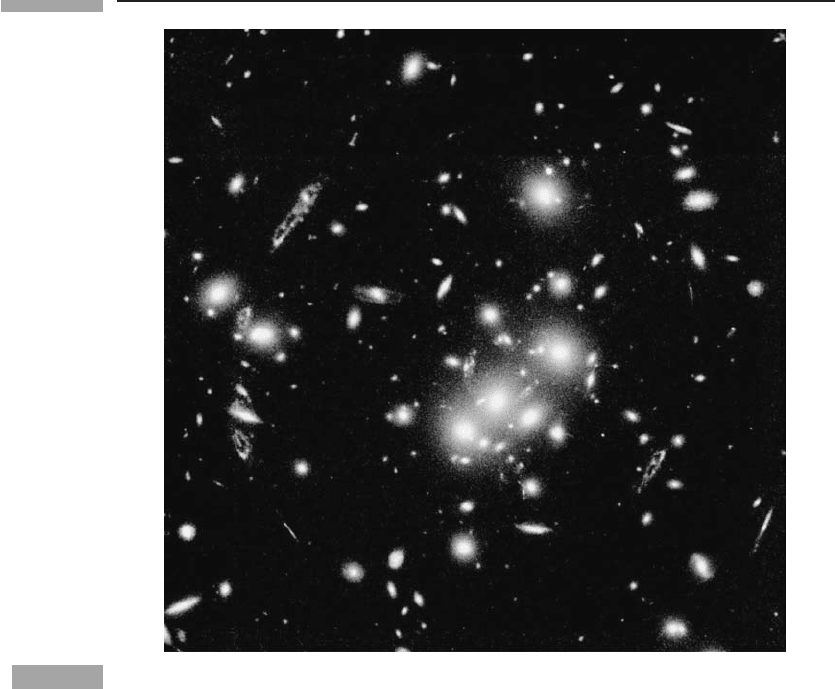Schutz B. A first course in general relativity
Подождите немного. Документ загружается.


293 11.1 Trajectories in the Schwarzschild spacetime
t
provide highly accurate predictions of the orbits of inspiralling neutron stars and black
holes, which are needed for the detection of the gravitational waves they emit (recall Ch. 9).
The post-Newtonian expansion assumes not just weak gravitational fields but also slow
velocities. The effect of this is that the Newtonian (Keplerian) motion of a planet depends
only on the g
00
part of the metric. The reason is that, in computing the total elapsed proper
time along the world line of the particle, the spatial distance increments the particle makes
(for example dr) are much smaller than the time increments dt, since dr/dt 1. Recall that
g
00
is also responsible for the gravitational redshift. It follows, therefore, that Newtonian
gravity can be identified with the gravitational redshift: knowing one determines the other
fully. Newtonian gravity is produced exclusively by the curvature of time in spacetime.
Spatial curvature comes in only at the level of post-Newtonian corrections.
Gravitational deflection of light
In our discussion of orbits we treated only particles, not photons, because photons do not
have bound orbits in Newtonian gravity. In this section we treat the analogous effect for
photons, their deflection from straight-line motion as they pass through a gravitational field.
Historically, this was the first general-relativistic effect to have been predicted before it was
observed, and its confirmation in the eclipse of 1919 (see McCrae 1979) made Einstein an
international celebrity. The fact that it was a British team (led by Eddington) who made the
observations to confirm the theories of a German physicist incidentally helped to alleviate
post-war tension between the scientific communities of the two countries. In modern times,
the light-deflection phenomenon has become a key tool of astronomy, as we describe in a
separate paragraph on gravitational lensing below. But first we need to understand how and
why gravity deflects light.
We begin by calculating the trajectory of a photon in the Schwarzschild metric under the
assumption that M/r is everywhere small along the trajectory. The equation of the orbit is
the ratio of Eq. (11.8) to the square root of Eq. (11.12):
dφ
dr
=±
1
r
2
$
1
b
2
−
1
r
2
1 −
2M
r
!
−1/2
, (11.47)
where we have defined the impact parameter,
b := L/E. (11.48)
In Exer. 1, § 11.7, it is shown that b would be the minimum value of r in Newtonian
theory, where there is no deflection. It therefore represents the ‘offset’ of the photon’s
initial trajectory from a parallel one moving purely radially. An incoming photon with
L > 0 obeys the equation
dφ
du
=
1
b
2
− u
2
+ 2Mu
3
−1/2
, (11.49)
with the same definition as before,
u = 1/r. (11.50)

294 Schwarzschild geometry and black holes
t
If we neglect the u
3
term in Eq. (11.49), all effects of M disappear, and the solution is
r sin(φ −φ
0
) = b, (11.51)
a straight line. This is, of course, the Newtonian result.
Suppose now we assume Mu 1 but not entirely negligible. Then if we define
y := u(1 − Mu), u = y(1 + My) +0(M
2
u
2
), (11.52)
Eq. (11.49) becomes
dφ
dy
=
(1 + 2My)
b
−2
− y
2
1/2
+ 0(M
2
u
2
). (11.53)
This can be integrated to give
φ = φ
0
+
2M
b
+ arcsin(by) −2M
1
b
2
− y
2
1/2
. (11.54)
The initial trajectory has y → 0, so φ → φ
0
: φ
0
is the incoming direction. The photon
reaches its smallest r when y = 1/b, as we can see from setting dr/dλ = 0inEq.(11.22)
and using our approximation Mu 1. This occurs at the angle φ = φ
0
+ 2M/b +π/2. It
has thus passed through an angle π/2 +2M/b as it travels to its point of closest approach.
By symmetry, it passes through a further angle of the same size as it moves outwards
from its point of closest approach (see Fig. 11.5). It thus passes through a total angle
of π + 4M/b. If it were going on a straight line, this angle would be π , so the net
deflection is
φ = 4M/b. (11.55)
To the accuracy of our approximations, we may use for b the radius of closest approach
rather than the impact parameter L/E. For the sum, the maximum effect is for trajectories
for which b = R
+
, the radius of the Sun. Given M = 1M
+
= 1.47 km and R
+
= 6.96 ×
10
5
km, we find
(φ)
+
,max
= 8.45 × 10
−6
rad = 1
.74. (11.56)
φ = φ
0
+ π +
φ = φ
0
4M
b
φ
= φ
0
+ +
2M
b
π
2
y
=
1
b
t
Figure 11.5
Deflection of a photon.

295 11.1 Trajectories in the Schwarzschild spacetime
t
φ
0
Sun
Satellite
n
→
s
→
a
→
To star
t
Figure 11.6
An observation from Earth of a star not at the limb of the Sun does not need to correct for the
full deflection of Fig. 11.5.
For Jupiter, with M = 1.12 × 10
−3
km and R = 6.98 ×10
4
km, we have
(φ)
,max
= 6.42 × 10
−8
rad = 0
.013. (11.57)
This deflection has been measured by the Hipparcos astrometry satellite.
Of course, satellite observations of stellar positions are made from a position near Earth,
and for stars that are not near the Sun in the sky the satellite will receive their light before
the total deflection, given by Eq. (11.55), has taken place. This situation is illustrated in
Fig. 11.6. An observer at rest at the position of the satellite observes an apparent position
in the direction of the vector a, tangent to the path of the light ray, and if he knows his
distance r from the Sun, he can calculate the true direction to the star, s. Exer. 16, § 11.7,
derives the general result.
Although the deflection of light was a key to establishing the correctness of general rel-
ativity, it is interesting that there is a purely Newtonian argument for light deflection. This
was first predicted by Cavendish in 1784 and independently by the German astronomer
J. G. von Söldner (1776–1833) in 1801. The argument relies on light behaving like a par-
ticle moving at speed c. Since the motion of a particle in a gravitational field depends only
on its velocity, Cavendish and von Söldner were able to compute the simple result that the
deflection would be 2M/b, exactly half of the prediction of general relativity in Eq. (11.55).
Einstein himself, unaware of this previous work, derived the same result in 1908, just at
the beginning of his quest for a relativistic theory of gravity. So the triumph of general
relativity was not that it predicted a deflection, but that it predicted the right amount of
deflection.
The reason that this Newtonian result is half of the fully relativistic one is not hard to
understand. Recall the remark at the end of the paragraph on post-Newtonian effects, that
the orbits of planets depend only on g
00
because their velocities are small. Now, light is
not slow: the spatial increments dr are comparable to the time increments dt. This means
that the spatial part of the metric, say g
rr
, are of equal weight with g
00
in determining the
motion of a photon. Looking at Eq. (11.44), we see that the deviations from flatness in
both g
00
and g
rr
are the same. Whatever deflection is produced by g
00
(the only part of the
metric that the Newtonian computations were sensitive to) is doubled by g
rr
. The extra-
large deflection of light in general relativity compared with Newtonian gravity is direct
evidence for the curvature of space as well as time.

296 Schwarzschild geometry and black holes
t
Gravitational lensing
It may of course happen that photons from the same star will travel trajectories that pass on
opposite sides of the deflecting star and intersect each other after deflection, as illustrated
in Fig. 11.7. Rays 1 and 2 are essentially parallel if the star (∗) is far from the deflecting
object (S). An observer at position B would then see two images of the star, coming from
apparently different directions.
This is a very simple and special arrangement of the objects, but it illustrates the prin-
ciple that gravitating bodies act as lenses. Lensing is essentially universal: no matter how
weak the deflection, it would always be possible to place the observer B far enough away
from S to see two rays from the same point on the source. We don’t get such “double
vision” when we look at the heavens because the probability of ‘being in exactly the right
spot’ B for any given star and lens is small, and because many sources are not pointlike
like our star: if the angular separation of the images at B (which is of order the deflection
angle) is small compared to the angular size of the object on the sky, then we are not likely
to be able to tell the difference between the two rays.
But as astronomers have built larger and more powerful telescopes, able to see much
greater distances into the universe, they have revealed a sky filled with lensed images. Of
particular importance is lensing by clusters of galaxies. There are so many galaxies in the
universe that, beyond any given relatively distant cluster, there is a high probability that
there will be another group of galaxies located in just the right position to be lensed into
multiple images in our telescope: the probability of ‘being in exactly the right spot’ has
become reasonably large. What is more, the masses of galaxy clusters are huge, so the
deflections are much bigger than the sizes of the more distant galaxy images, so separating
them is not a problem. In fact, we often see multiple images of the same object, created by
the irregularities of the lensing mass distribution. A good example is in Fig. 11.8.
Even more important than the creation of separate images can be the brightening of
single images by the focusing of light from them. This is called magnification. The mag-
nification of galaxy images by lensing makes it possible for astronomers to see galaxies at
greater distances, and has helped studies of the very early universe. Lensing also helps us
map the mass distribution of the lensing cluster, and this has shown that clusters have much
more mass than can be associated with their luminous stars. Astronomers call this dark
matter, and it will be an important subject in the next chapter, when we discuss cosmology.
Detailed modeling of observed lenses has shown that the dark matter is distributed more
smoothly inside clusters than the stars, which clump into the individual galaxies. The mass
of a cluster may be ten or more times the mass of its stars. The dark matter is presumably
S
B
1
2
t
Figure 11.7
Deflection can produce multiple images.

297 11.1 Trajectories in the Schwarzschild spacetime
t
t
Figure 11.8
A picture taken with the Hubble Space Telescope of a cluster called 0024+1654 (fuzzy round
galaxies) showing many images of a much more distant galaxy. The images are distorted, all of
them stretched in the direction transverse to the line joining the image and the center of the
cluster, and compressed along this line. Picture courtesy of W. N. Colley and E. Turner (Princeton
University), J. A. Tyson (Bell Labs, Lucent Technologies) and NASA.
made of something that carries no electric charge, because light from the distant galaxies
passes through it without absorption or scattering, and it seems to emit no electromagnetic
radiation. Physicists do not know of any elementary particle that could serve as dark matter
in this way: apart from neutrinos, all electrically neutral particles known at present (2008)
are unstable and decay quickly. And neutrinos are thought to be too light to have been
trapped in the gravitational fields of clusters. Dark matter is one of the biggest mysteries at
the intersection of astronomy and particle physics today.
Studies of gravitational lensing have the potential to reveal any matter that clumps in
some way. Lensing observations of individual stars in our galaxy (microlensing) have
shown that there appears to be a population of objects with stellar masses that are also
dark: they are observed only because they pass across more distant stars in our Galaxy and
produce lensing. In this case, observers do not see two separate images. Instead, they see
is brightening of the distant star, caused by the fact that the lens focuses more light on

298 Schwarzschild geometry and black holes
t
the telescope than would reach it if the lens were not there. This brightening is temporary
because the lensing object itself moves, and so the lensing event is transitory. Optical stud-
ies of the region around the lensed stars have shown that the lensing object is not as bright
as a normal white dwarf star but has a mass that is a good fraction of a solar mass. The
nature of these lensing objects, which could represent a significant fraction of the mass of
the Galaxy, is still (2008) a mystery.
11.2 N a tu re o f t h e s u r fa ce r = 2M
Coordinate singularities
It is clear that something funny goes wrong with the line element, Eq. (11.1)atr = 2M,but
what is not clear is whether the problem is with the geometry or just with the coordinates.
Coordinate singularities – places where the coordinates don’t describe the geometry prop-
erly – are not unknown in ordinary calculus. Consider spherical coordinates at the poles.
The north pole on a sphere has coordinates θ = 0, 0 φ<2π . That is, although φ can
have any value for θ = 0, all values really correspond to a single point. We might draw a
coordinate diagram of the sphere as follows (Fig. 11.9 – maps of the globe are sometimes
drawn this way), in which it would not be at all obvious that all points at θ = 0 are really
the same point. We could, however, convince ourselves of this by calculating the circum-
ference of every circle of constant θ and verifying that these approached zero as θ → 0
and θ → π . That is, by asking questions that have an invariant geometrical meaning, we
can tell if the coordinates are bad. For the sphere, the metric is positive-definite, so if two
points have zero distance between them, they are the same point (e.g. θ = 0, φ = π and
θ = 0, φ = 2π: see Exer. 18, § 11.7). In relativity, the situation is more subtle, since there
are curves (null curves) where distinct points have zero invariant distance between them.
In fact, the whole question of the nature of the surface r = 2M is so subtle that it was not
answered satisfactorily until 1960. (This was just in time, too, since black holes began to
π
π
π
/
23π
/
22ππ
φ
θ
2
0
0
t
Figure 11.9
One way of drawing as sphere on a flat piece of paper. Not only are φ = 0andφ = 2π really the
same lines, but the lines θ = 0andθ = π are each really j ust one point. Spherical coordinates are
therefore not faithful representations of the sphere everywhere.

299 11.2 Nature of the surface r = 2M
t
be of importance in astronomy within a decade as new technology made observations of
quasars, pulsars, and X-ray sources possible.) We shall explore the problem by asking a
few geometrical questions about the metric and then demonstrating a coordinate system
which has no singularity at this surface.
Infalling particles
Let a particle fall to the surface r = 2M from any finite radius R. How much proper time
does that take? That is, how much time has elapsed on the particle’s clock? The simplest
particle to discuss is the one that falls in radially. Since dφ = 0, we have
˜
L = 0 and, from
Eq. (11.11),
dr
dτ
2
=
˜
E
2
− 1 +
2M
r
, (11.58)
or
dτ =−
dr
-
˜
E
2
− 1 + 2M/r
.
1/2
(11.59)
(the minus sign because the particle falls inward). It is clear that if
˜
E
2
> 1 (unbound par-
ticle), the integral of the right-hand side from R to 2M is finite. If
˜
E = 1 (particle falling
from rest at ∞), the integral is simply
τ =
4M
3
$
-
r
2M
.
3/2
!
R
2M
, (11.60)
which is again finite. And if
˜
E < 1, there is again no problem since the particle cannot be
at larger r than where 1 −
˜
E
2
= 2M/r (see Eq. (11.58)). So the answer is that any particle
can reach the horizon in a finite amount of proper time. In fact there is nothing about the
integral that prevents us placing the lower limit smaller than 2M, that is the other side of
the surface r = 2M. The particle apparently can go inside r = 2M in a finite proper time.
We now ask how much coordinate time elapses as the particle falls in. For this we use
U
0
=
dt
dτ
= g
00
U
0
= g
00
p
o
m
=−g
00
˜
E =
1 −
2M
r
−1
˜
E.
Therefore we have
dt =
˜
E dτ
1 − 2M/r
=−
˜
E dr
(1 − 2M/r)(
˜
E
2
− 1 +2M/r)
1/2
. (11.61)
For simplicity, we again consider the case
˜
E = 1 and examine this near r = 2M by defining
the new variable
ε := r −2M.
Then we get
dt =
−(ε + 2M)
3/2
dε
(2M)
1/2
ε
. (11.62)

300 Schwarzschild geometry and black holes
t
It is clear that as ε → 0 the integral of this goes like In ε, which diverges. We would also
find this for
˜
E = 1, because the divergence comes from the [1 −(2M/r)]
−1
term, which
doesn’t contain
˜
E. Therefore a particle reaches the surface r = 2M only after an infinite
coordinate time has elapsed. Since the proper time is finite, the coordinate time must be
behaving badly.
Inside r = 2M
To see just how badly it behaves, let us ask what happens to a particle after it reaches
r = 2M. It must clearly pass to smaller r unless it is destroyed. This might happen if at
r = 2M there were a ‘curvature singularity’, where the gravitational forces grew strong
enough to tear anything apart. But calculation of the components R
α
βμν
of Riemannian
tensor in the local inertial frame of the infalling particle shows them to be perfectly finite:
Exer. 20, § 11.7. So we must conclude that the particle will just keep going. If we look at
the geometry inside but near r = 2M, by introducing ε := 2M − r, then the line element is
ds
2
=
ε
2M − ε
dt
2
−
2M − ε
ε
dε
2
+ (2M − ε)
2
d
2
. (11.63)
Since ε>0insider = 2M, we see that a line on which t, θ , φ are constant has ds
2
< 0: it
is timelike. Therefore ε (and hence r)isatimelike coordnate, while t has become spacelike:
even more evidence for the funniness of t and r! Since the infalling particle must follow a
timelike world line, it must constantly change r, and of course this means decrease r.So
a particle inside r = 2M will inevitably reach r = 0, and there a true curvature singulaity
awaits it: sure destruction by infinite forces (Exer. 20, § 11.7). But what happens if the
particle inside r = 2M tries to send out a photon to someone outside r = 2M in order to
describe his impending doom? This photon, no matter how directed, must also go forward
in ‘time’ as seen locally by the particle, and this means to decreasing r. So the photon
will not get out either. Everything inside r = 2M is trapped and, moreover, doomed to
encounter the singularity at r = 0, since r = 0 is in the future of every timelike and null
world line inside r = 2M. Once a particle crosses the surface r = 2M, it cannot be seen by
an external observer, since to be seen means to send out a photon which reaches the external
observer. This surface is therefore called a horizon, since a horizon on Earth has the same
effect (for different reasons!). We shall henceforth refer to r = 2M as the Schwarzschild
horizon.
Coordinate systems
So far, our approach has been purely algebraic – we have no ‘picture’ of the geometry. To
develop a picture we will first draw a coordinate diagram in Schwarzschild coordinates,
and on it we will draw the light cones, or at least the paths of the radially ingoing and
outgoing null lines emanating from certain events (Fig. 11.10). These light cones may be
calculated by solving ds
2
= 0forθ and φ constant:

301 11.2 Nature of the surface r = 2M
t
r
2M
t
t
Figure 11.10
Light cones drawn in Schwarzschild coordinates close up near the surface r = 2M.
dt
dr
=±
1 −
2M
r
−1
. (11.64)
In a t −r diagram, these lines have slope ±1 far from the star (standard SR light cone)
but their slope approaches ±∞as r → 2M. This means that they become more vertical:
the cone ‘closes up’. Since particle world lines are confined within the local light cone
(a particle must move slower than light), this closing up of the cones forces the world lines
of particles to become more vertical: if they reach r = 2M, they reach it at t =∞.This
is the ‘picture’ behind the algebraic result that a particle takes infinite coordinate time to
reach the horizon. Notice that no particle world line reaches the line r = 2M for any finite
value of t. This might suggest that the line (r = 2M, −∞ < t < ∞) is really not a line at
all but a single point in spacetime. That is, our coordinates may go bad by expanding a
single event into the whole line r = 2M, which would have the effect that if any particle
reached the horizon after that event, then it would have to cross r = 2M ‘after’ t =+∞.
This singularity would then be very like the one in Fig. 11.9 for spherical coordinates at the
pole: a whole line in the bad coordinates representing a point in the real space. Notice that
the coordinate diagram in Fig. 11.10 makes no attempt to represent the geometry properly,
only the coordinates. It clearly does a poor job on the geometry because the light cones
close up. Since we have already decided that they don’t really close up (particles reach the
horizon at finite proper time and encounter a perfectly well-behaved geometry there), the
remedy is to find coordinates which do not close up the light cones.
Kruskal–Szekeres coordinates
The search for these coordinates was a long and difficult one, and ended in 1960. The
good coordinates are known as Kruskal–Szekeres coordinates, are called u and v, and are
defined by

302 Schwarzschild geometry and black holes
t
u = (r/2M − 1)
1/2
e
r/4M
cosh(t/4M),
v = (r/2M − 1)
1/2
e
r/4M
sinh(t/4M),
(11.65)
for r > 2M and
u = (1 − r/2M)
1/2
e
r/4M
sinh(t/4M),
v = (1 −r/2M)
1/2
e
r/4M
cosh(t/4M),
(11.66)
for r < 2M. (This transformation is singular at r =2M, but that is necessary in order to
eliminate the coordinate singularity there.) The metric in these coordinates is found to be
ds
2
=−
32M
3
r
e
−r/2M
(dv
2
− du
2
) + r
2
d
2
, (11.67)
where, now, r is not to be regarded as a coordinate but as a function of u and v,given
implicitly by the inverse of Eqs. (11.65) and (11.66):
-
r
2M
− 1
.
e
r/2M
= u
2
− v
2
. (11.68)
Notice several things about Eq. (11.67). There is nothing singular about any metric term
at r = 2M. There is, however, a singularity at r = 0, where we expect it. A radial null line
(dθ = dφ = ds = 0) is a line
dv =±du. (11.69)
This last result is very important. It means that in a (u, υ) diagram, the light cones are all
as open as in SR. This result makes these coordinates particularly useful for visualizing
the geometry in a coordinate diagram. The (u, υ) diagram is, then, given in Fig. 11.11.
Compare this with the result of Exer. 21, § 5.8.
IV
III
I
II
r
=
c
o
n
s
t
r
=
0
r = const
t
= const
r
=
2M, t = ∞
t
Figure 11.11
Kruskal–Szekeres coordinates keep the l ight cones at 45
◦
everywhere. The singularity at r = 0
(toothed line) bounds the future of all events inside (above) the line r = 2M, t =+∞.Events
outside this horizon have part of their future free of singularities.
